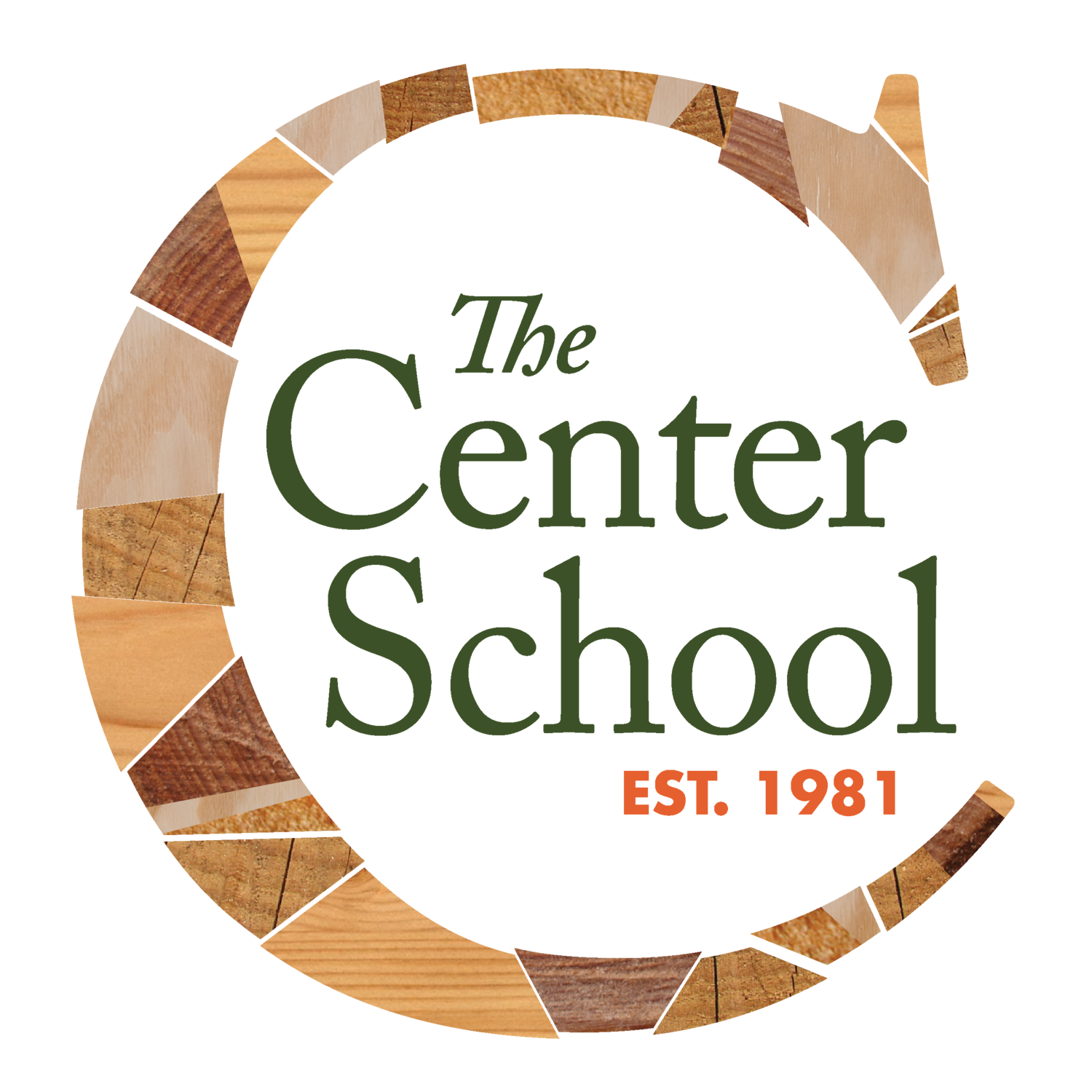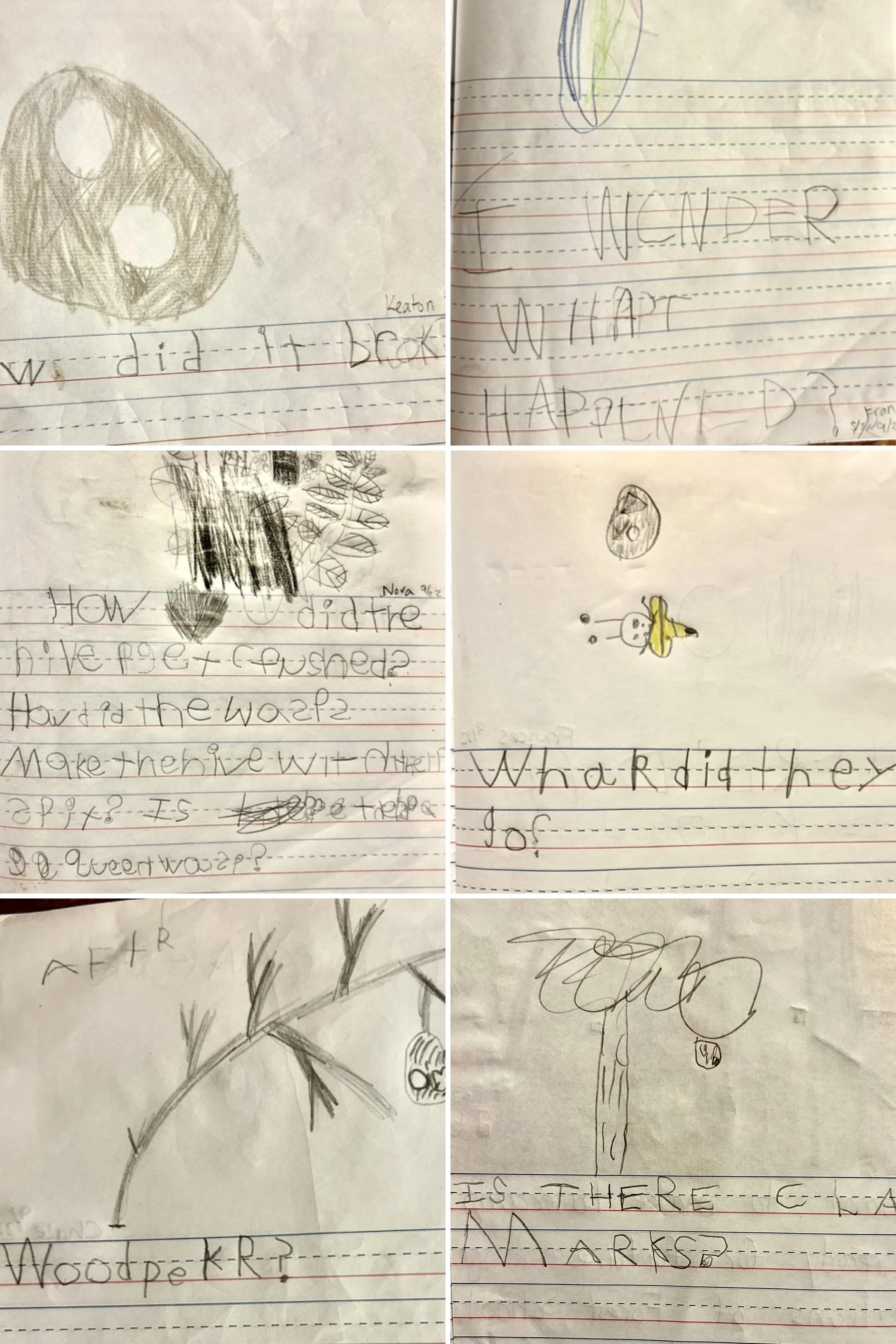Building Community Through Wonder: The Woods Primes’ Wasp Nests
During the first few weeks of school, the Woods Primes made an exciting discovery at their basecamp—an active wasp nest! Teachers quickly marked off a safe boundary, allowing students to observe the nest from a respectful distance. Over the following days, the children watched closely and asked many thoughtful questions:
How was the nest made?
When were the wasps most active? (We noticed that the yellow jackets became busier as the mornings warmed up.) Was there an exact temperature that made them come out?
Why do wasps love apples and peaches so much?
Some students started to develop relationships with some of the wasps and started naming them. There was Fluffy, Mango and Joe. They wondered if they studied the wasps long enough if they would start to notice distinguishing features so that they could differentiate one from another.
As we explored these wonderings, we learned that wasps create their paper-like nests by chewing wood fibers and mixing them with saliva—a natural form of papier-mâché! Inspired by this process, the Woods Primes decided to make their own model nest using a balloon, shredded newspaper, and a paste to hold it together.
As the project took shape, we realized that this hive could represent more than just our scientific curiosity—it could serve as a symbol of our growing community. Just as wasps work together to build their nest, we were coming together to build our classroom culture. To make our model nest truly our own, we decided to decorate it with the “agreements” we had brainstormed earlier in the week about how we wanted TO BE together as a community. Some of their ideas included:
Be yourself
Be safe
Be inspired
Be mindblowing
Be forgiving
Be loving
Be awesome
Be calm and gentle
Be creative
Be fun
Stick up for yourself
Be a good community
Take care of nature
Be welcoming
Be nurturing
Be careful
Be kind
Be inclusive
Be playful
Take care of nature
Be encouraging
As we discussed each idea, we decided together whether it should become part of our hive in a special “agreement ceremony.” Only the words that everyone agreed upon were added to the paper layers. The few that didn’t make it sparked thoughtful conversations and opportunities to reflect on each other’s perspectives. We found that four phrases didn’t reach full consensus:
Be everything – Some students felt this was too much pressure. How can you really be everything?! We were impressed by the awareness of their own human limitations and ability to articulate boundaries. We decided to leave it off.
Be good – Some thought it sounded like if we included this, they’d have to be perfect, without room for making mistakes. Later on we decided to clarify that we in fact needed to make mistakes in order to learn and grow and we decided to put on Be your best good as a statement of the good will amongst our kind hearted students.
Be brave – Some worried this might mean being pushed to do things that felt uncomfortable before they were mentally prepared. After debating this concept for some time the Woods Primes eventually settled on Try new things as a term to describe the culture that they want to create around risk taking.
Be curious – A few wondered whether curiosity could sometimes lead to harm if not used thoughtfully. After revisiting this conversation several times we eventually decided that Be safely curious could be added to the model nest.
While we were deep in our hive-making work, a storm swept through basecamp and destroyed the real wasp nest, leaving it tattered and empty. Once we confirmed that the wasps had indeed moved on, we asked the children what they thought we should do with the remains of the real nest.
Here’s some of their thinking:
Liliana: “I feel like it will be fun to see what the wasps made. Can we touch it?”
Whitney: “I think we should take it down and tear it up. We could make Center School honey if there was honey in it.”
Chase: “If we can put it back after we take it down, I’m OK with it.”
Fred: “I don’t wanna take it down or apart. If we take it down, it could get lost.”
Dash: “I want to take it apart, and if we leave it up, the wind might tear it up and loosen it too.”
Nova: “I don’t wanna take it down. I want to take it down, but if we take it down, we could put up our fake wasp nest. And if we take it down, we might hurt the tree.”
Kestrel: “I’m kind of connecting with Nova’s idea of using the wasp on our fake nest.”
Whitney: “I think we could cut it down slowly. We could look on top and look inside for honey, and then bring it inside and take all the honey out. We could make two beehives—the next one could be a painted one.”
Fred: “If we paint it, then we wouldn’t have one just made of nature.”
Kestrel: “Instead of bringing it inside, we can make a store outside and use a branch and string to make a shop, and we could hang both of them at the store.”
Liliana: “I think we should share about it at All School.”
Nova: “Before we decide on all these ideas, I think we should investigate to see how sturdy the tree is and how hard it would be to take the nest down.”
Sam: “One way we can cut it down—we could use a knife so half of the top could be left.”
Keaton: “We could cut it down slowly.”
Nova: “We all care about nature! I want to leave it there. I want to let nature take it down, and that baby tree is so small—it may hurt it. And maybe, just maybe, another wasp might come along and make it their home. But if we do take it down, I want to put it in the front office. I can be flexible, but I really just want nature to take it down—or maybe it will recarbonate into soil.”
Fred: “I think we could get Amy’s drill and drill around the branch, or we could use clippers, because it’s going to be winter and soon everything will die.”
Liliana: “I’m connecting to Sam, but I think we could not use half—just a little bit.”
Sam: “Maybe we could leave the nest but use tweezers to take out the dead wasps and put them on our fake wasp nest. Maybe we can get tweezers and a bowl and get dead wasps and put them in the bowl.”
Liliana: “And we can put the dead wasps on our fake wasp nest.”
Through this rich dialogue, the Woods Primes demonstrated the heart of their classroom community—creativity, curiosity, collaboration, care for nature, and respect for one another’s ideas. Our study of the wasp nest became much more than a science lesson; it became a living metaphor for how we are learning to build, question, and grow together. We decided to do nothing with the real nest and instead invited the children to visit the wasp nest once again, this time much closer, to write down what they see, think, or wonder about.
See
The before, after, and now of the wasp nest – Chase
It looks like the paper is popping (off). – Kestrel
I see it got broken. – Korra
I love you Fluffy! -Dash
Think
Maybe backyard bear attacked it? – Whitney
I think a bird pecked at it. – Whitney
I think a skunk attacked it. – Poe
Maybe they abandoned it? – Poe
Wonder
How did it break? – Keaton
I wonder what happened? - Frances
How did the hive get crushed? How did the wasps make the hive with spit? Is there a queen wasp? – Nova
Where did they go? – Liliana
Woodpecker? – Fred
Is there claw marks? – Sam
We realized that our classroom community isn’t so different from a wasp nest: it takes teamwork, creativity, and a lot of care to build a community that is both mindblowing and inclusive. Just like the wasps make their nests layer by layer, our community grows a little at a time, with kindness and curiosity (and a whole lot of fun!) to hold it all together.








